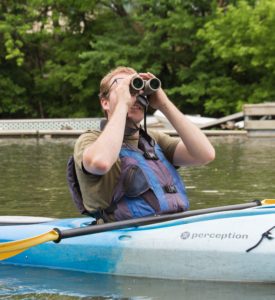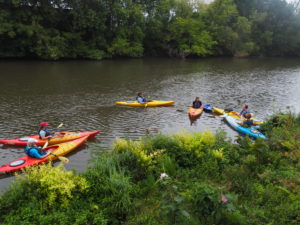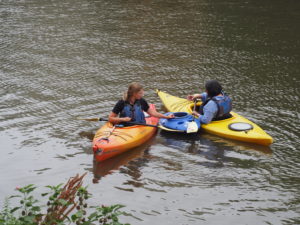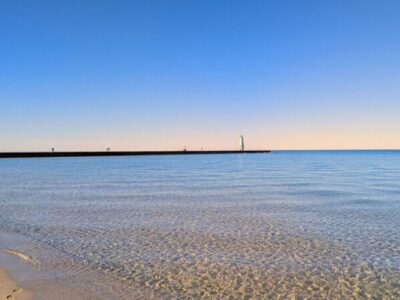
“Trash safari, woo!” Edward Warden shouted gleefully as he and five others paddled their kayaks past a Whole Foods on the Chicago River. By the sounds of it, everyone was having a ball.

Edward Warden, courtesy of Shedd Aquarium
It was mid-morning in September, mist obscuring skyscrapers and painting the water and sky into a grayscale landscape. The red, yellow and blue boats served as bright daubs of color on the calm river, alongside greenery that has blossomed from human-made floating islands.
This is the river’s “Wild Mile,” and three visitors plus three Shedd Aquarium employees were visiting the area to monitor wildlife, enjoy the city from a different perspective—and use their trash harpoons to collect floating debris. The cans, bottles, and assorted junk all went into the blue “garbage barges” being pulled by Shedd employees.
This summer marked the launch of Shedd’s Kayak for Conservation program. The tours bring city-dwellers onto the Chicago River, what Warden, who’s part of Shedd’s conservation stewardship team, calls “Chicago’s second waterfront.”
“We live in a society where we’ve had a lot of disconnect from our environment. Where water comes from, where food comes from, the air that we breathe,” Warden said. “We hope to get people not only aware of the [river’s] situation, but also engaged in it and its continued improvement.”

Shedd Aquarium Kayak for Conservation, Photo by Lorraine Boissoneault
In addition to visiting the floating islands Shedd employees installed to provide wildlife habitat and absorb excess nutrients that run off into the river, the visiting paddlers also pitch in as cheerful cleanup crews. This summer alone, over 500 participants have collected more than 5,400 pieces of trash. Even when people can’t collect the trash because it’s too far out of reach or a little too gross, they still record it in spreadsheets. All that data will help paint a clearer picture of what kind of refuse is sliding into the river and perhaps lead to ways of managing it in the future.
As for whether people actually enjoy going out for a paddle and grasping after garbage …
“I recommend that for anybody who has the time to do it,” said John Kallend, a retired professor of engineering, upon disembarking from his boat at the end of the tour. Kallend is an Aquarium Council member and has been on numerous outings with the institution. But this experience was unique in how much participants were asked to contribute.
Normally, Kallend said, he gets to see scientists doing cool things. But in this case, he and the other participants were the ones helping the planet. “You’re out on the kayak, you’re on the river and you get a different view of the city, and you’re also being challenged,” he said.

Shedd Aquarium Kayak for Conservation, Photo by Lorraine Boissoneault
Maybe that dark floating object is a leaf, or maybe it’s a piece of debris. Maybe it’s even a toy gun, like the one Kallend found. For him, it was as much a treasure hunt as a nature experience. Or, as one staff member put it, a “trash-ure” hunt.
“I thought it was fascinating,” agreed Mary Lawlor, another Aquarium Council member and retired physician. “To me, the Shedd is very cool to go to and see all the tropical reefs, but really it’s about us, it’s about Lake Michigan, it’s about the Chicago River.”
As for Warden, a self-described bird enthusiast, he’s most excited when he can show people wildlife they don’t normally have the opportunity to see. But getting data on litter is also a huge plus for scientists, since no research has previously been done on the subject.
Birds, bugs, and mildewing bottles. All in a day’s work on the Chicago River.
1 Comment
-
The video was interesting, as I had no idea that there were those floating islands in the Chicago River. One question I have is that they said a few times that the river flow had been reversed. How did they do that & why? Keep up the good work on conservation.




